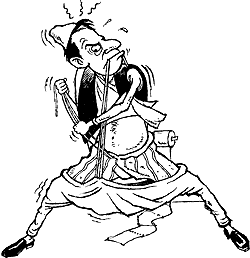From Nepali Times, ISSUE #143 (02 MAY 2003 – 08 MAY 2003)
A visiting Nepali dignitary clad in his national dress was once spoofed by the British press for arriving in his long johns
The male attire that is the Nepali national dress came to the middle Himalaya from Rajasthan: proof for Kathmandu’s warrior-caste elite to trace its bloodline back to the wild western desert. 
The labeda, daura or mayelpose is a double-breasted kurta whose flaps are battened down in four places with ties, in a diagonal across the chest. The bottom is the suruwal, the same as what the British named jodhpurs, it is skin-tight around the calves, growing to incongruous pleated proportions around the groin.
The topi was already there, and at some point during the time that Nepal was never colonised by the Company Bahadur, the Western jacket arrived, to be called ‘coat’. The national dress of Nepal now comes in four pieces: the topi which can be dented and fashioned to create individual signatures; a most distinctive labeda top, the coat which completely covers whatever is distinctive about the labeda, and the suruwal, an uncomfortable bottom that sometimes comes with a full legged inner (bhitri). Way back in 1980, a Kathmandu dignitary visiting London was spoofed in a television program as having arrived at Heathrow in his long johns.
In the sweltering heat of the tarai, home to some of the hottest temperatures of South Asia, civil servants have to suffer this double-breasted and jacketed nationalism. Dull and uncomfortable, the labeda-suruwal has come to represent the state and its functionaries, through years of authoritarian figures strutting about in it, large bellies accentuated by the unflattering fall of the labeda.
There is more that is comical about the dress: when the male official goes up to a sofa on the podium, he has first to reach to his rear with two hands and flip the fall of the labeda up so that it rides up the back before he can make to sit. This is to save the ironing. Once the official is properly seated, members of the audience are afforded a grandstand view of the dejected sac of pleated cloth gathered between the legs.
The greatest challenge faced by he who wears the labeda-suruwal is the visit to the water closet is a secret. For who would want to share this embarrassment with the world? Let me lead you through the ritual step-by-delicate step.
First, park your topi in your coat pocket. Then unbutton your coat and shunt the two fronts aside. Turn the two front flaps of the labeda all the way up, and hold them there firmly with your chin against your chest. Loosen the injaar or drawstring and push the suruwal down. But remember to have both legs slightly akimbo so that you do not have the suruwal gathered at the ankles on the (wet.) floor. If a true traditionalist, you will have a bhitri-suruwal, and will need to repeat the procedure before you are ready to water the closet.
Life was never meant to be this complicated, and we wait for the great founder nation of SAARC to modernise its national dress. There is a lot at stake. Imagine a regional summit meeting at the Birendra International Convention Centre in downtown Kathmandu. As fellow South Asians zip in, zip down, zip up and zip out, the Nepali under-secretary in the ministry of foreign affairs is still only getting started with the first stage of the disrobing operation. Think of all the time spent away from the plenary Compute all the minutes spent struggling with the labeda-suruwal, and calculate an average two to three visits to the water closet on every workday. Multiply the minutes with the number of male civil servants in government employ, from the line ministries to the village development committees, and you will see how our Himalayan kingdom’s development is retarded.
(Originally published in Himal South Asian.)